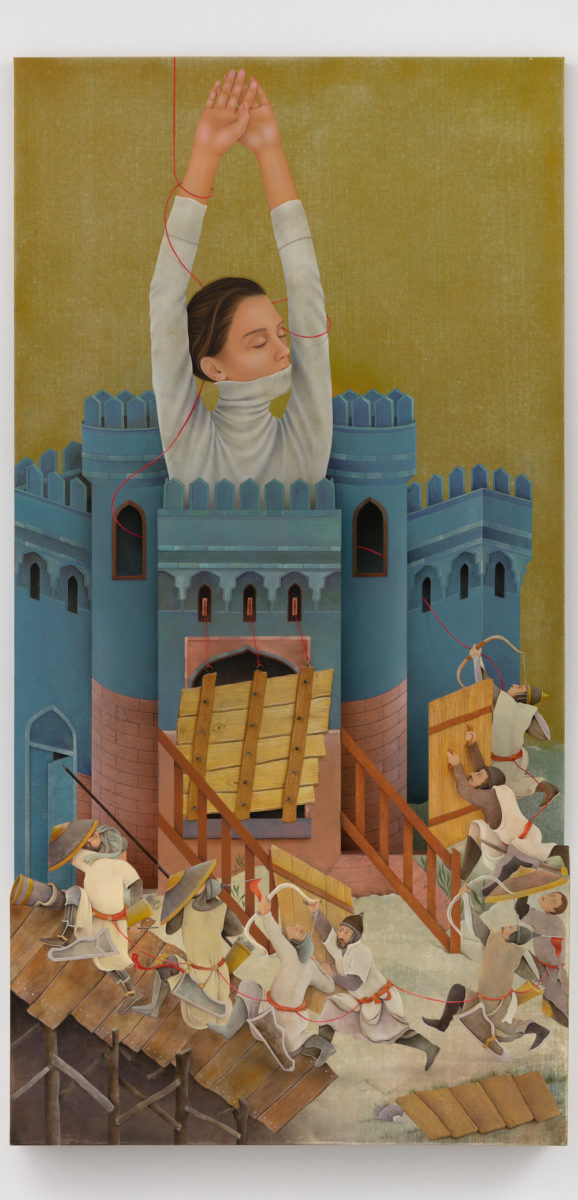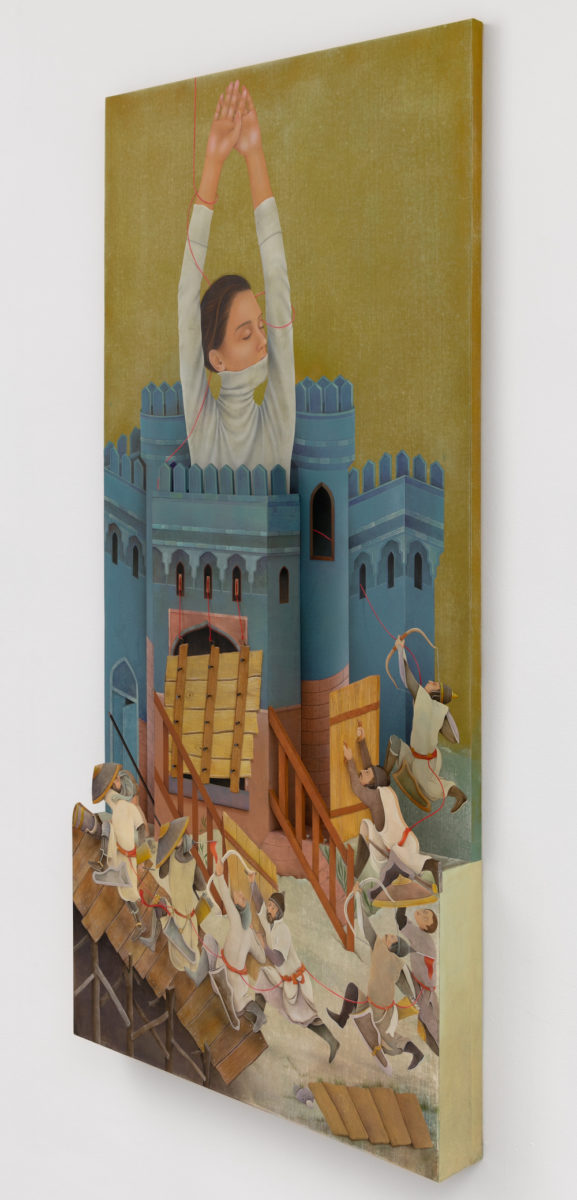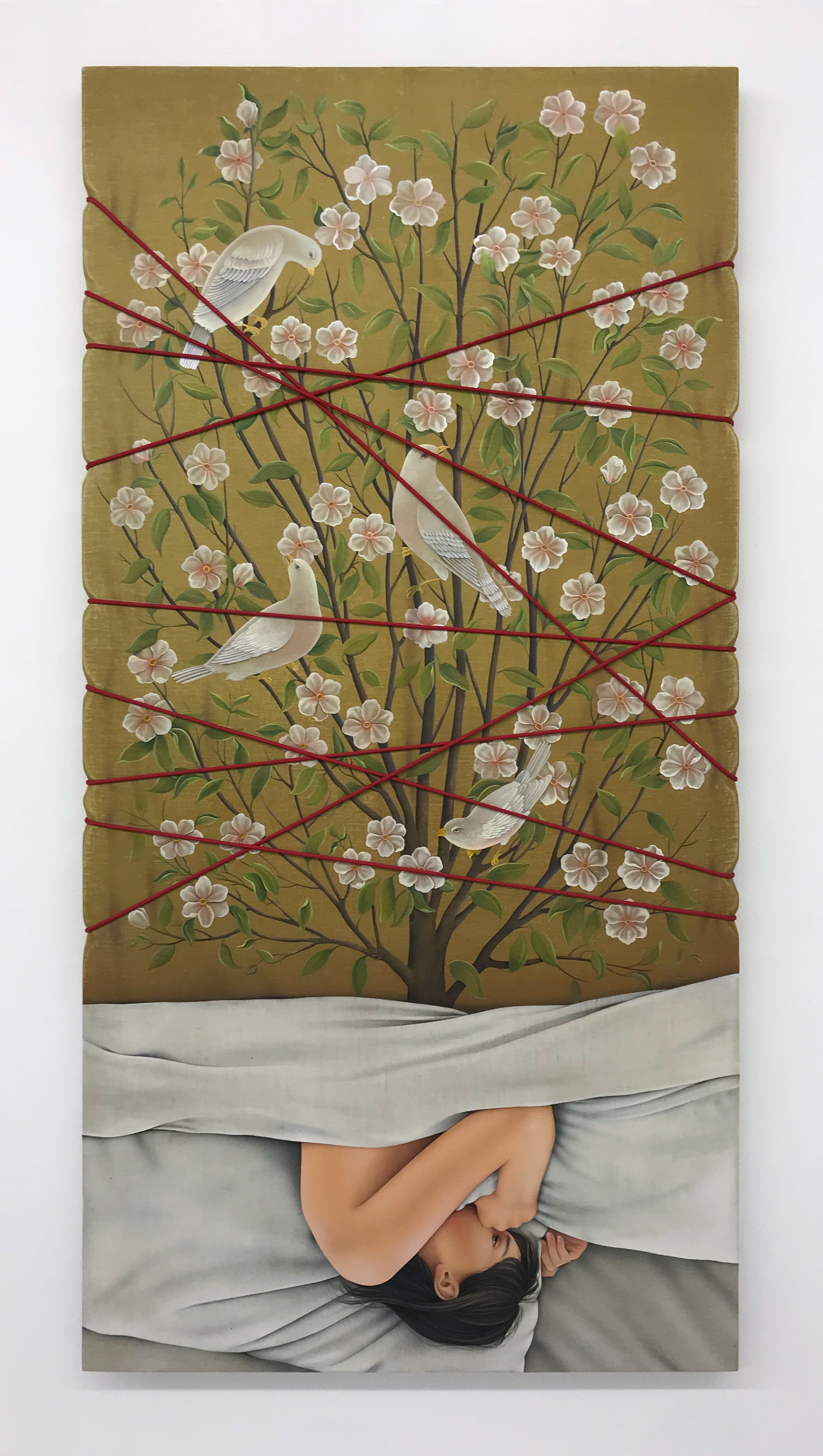
Arghavan Khosravi explores oppression in her work, though her paintings—meticulously created and borrowing techniques from Persian miniatures—don’t provide a cut and dried image of it as something dark and harrowing. Instead, this is suggested by the boxing in of her subjects, who sometimes appear contained and restricted by the physical edges of the paintings and are sometimes presented as cleanly disembodied limbs and floating heads.
“Everyone is expected to abide by what the system dictates”
Many elements of her work hints at an underlying darkness, but the luscious colours and playful composition work to semi-conceal this. The artist moved from Iran to the US four years ago, and explores ideas of societal control and passive violence. I spoke with her just before she opened a solo exhibition at Lyles & King gallery in New York. Titled Tightrope Walking the Red Lines, the works in the show continue her recent inclusion of a fine red thread running through her paintings, “a delicate yet constant presence of control and repression”.
Can you tell me a little about your current show at Lyles & King?
The paintings all reflect on my memories from Iran. This is the fourth year that I’ve been living in the States, so it was a good amount of time and distance—both psychological and geographical—to look back. The work focuses more on cultural memories, in a collective manner, than something totally personal (although there are moments in some paintings that are more personal). I’m thinking about me, my generation and other people, and what they’re experiencing in Iran.
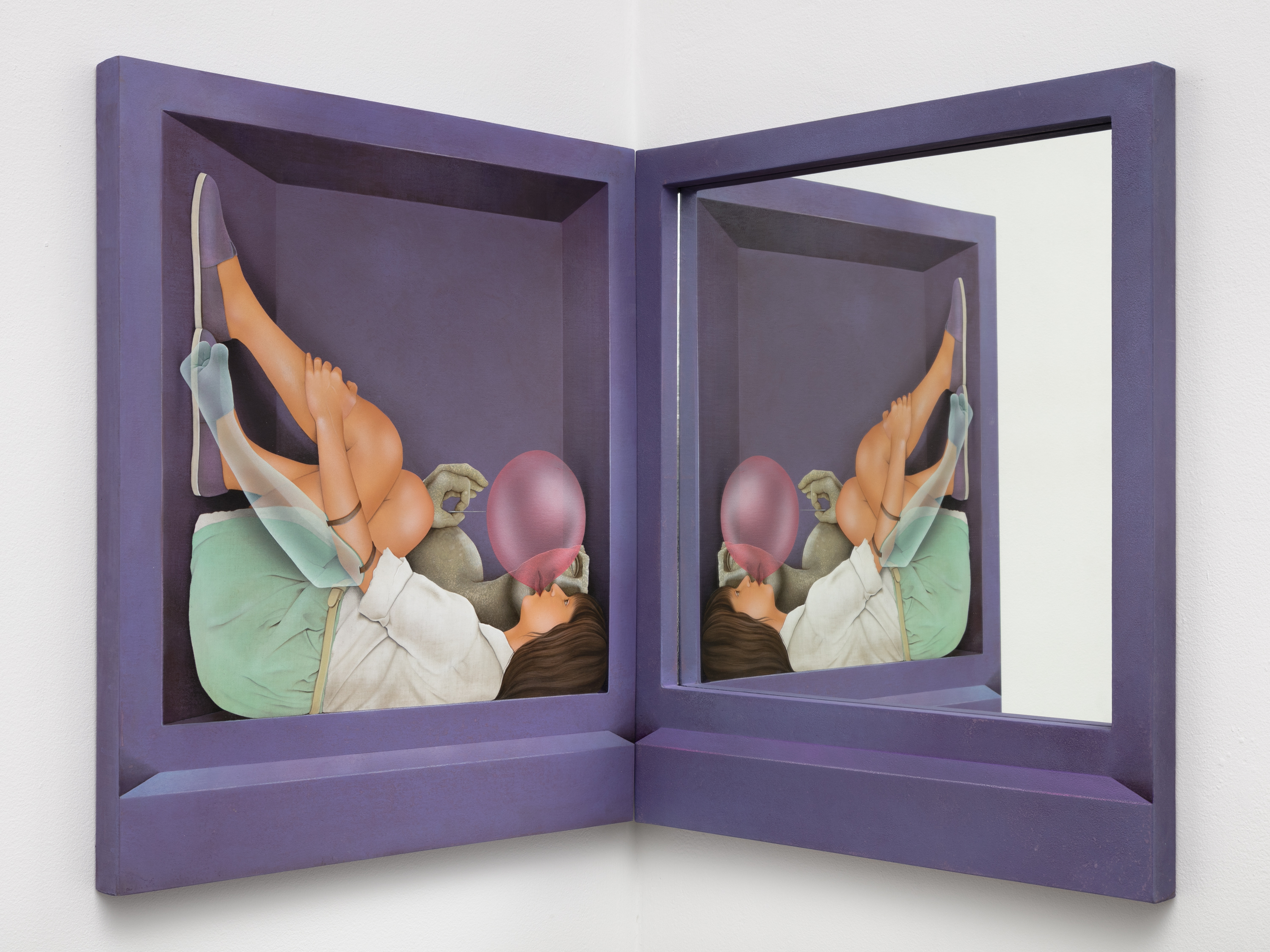
Do you think that living in America has given you a very different view of Iran?
I was born and spent all my life in Iran, and whenever I was abroad, it was just for a treat. This is the longest time I’ve been away and I can look at things, not from the outside, but from some sort of distance. For example, in Iran, women are forced to wear a hijab when outside in public spaces. I was born under such circumstances, and I knew that it was unfair, but it’s a part of life there. Now that I’m outside—every day I’m going out, I feel the sunshine on my hair—I see it as extraordinarily unfair. It’s when you look back at things that you realize what you were going through was forced upon you. But I’m not looking at everything with a really dark lens. It’s a conversation.
“I didn’t want it to be too direct and I didn’t want it to be violent”
I feel like your paintings have a really fine balance; they are very dark in some respects but there’s also something really peaceful about them, and a lot of the colours that you use are bright.
Yeah, I’m glad to hear that because I’m trying to find that, not balance, but something that is honest about how I’m feeling. And it’s not something totally dark or negative. I think that in the end, we are all destined to be hopeful.
Obviously America is troubled in its own way as well right now. You moved there when things were a bit more hopeful. How have you experienced that change while living there?
I was lucky to be here for a year under Obama’s administration. But now the Iran/US relations are really turbulent. Every morning I check Twitter and see what new thing Trump has tweeted about Iran. The worst thing was when he signed the executive order on the travel ban. I was visiting Iran just for a week and it was when I came back to the US that he signed the order. I was on my student visa so I could have got stuck in Iran if I was staying a week longer. So it was really stressful. And I felt I was so disrespected.

I’m really interested in how you work with the body; it feels quite segmented or pulled apart. There are lots of cracks in the painted forms in your works, and body parts coming out from behind other shapes. Can you tell me a little bit about that?
One of the things I’m thinking about is the body, and more specifically the female body. I’m looking through my own lens, as a woman who spent most of my life in Iran and now live in the US. It gives me the feeling of being a part of the system, and everyone is expected to abide by what the system dictates. So that’s why sometimes the bodies are, maybe less so in these works, but in previous works, kind of segmented. I think it’s interesting because it activates the audience’s imagination and they can fill the empty spaces with their own narrative. I want my paintings to be, to some extent, open to different interpretations, based on the viewer’s own way of thinking, influenced by whatever they have gone through up until the moment when they’re standing in front of my painting. And I don’t necessarily want to dictate exactly what I mean by the painting, although I do often have some specific narrative in my mind.
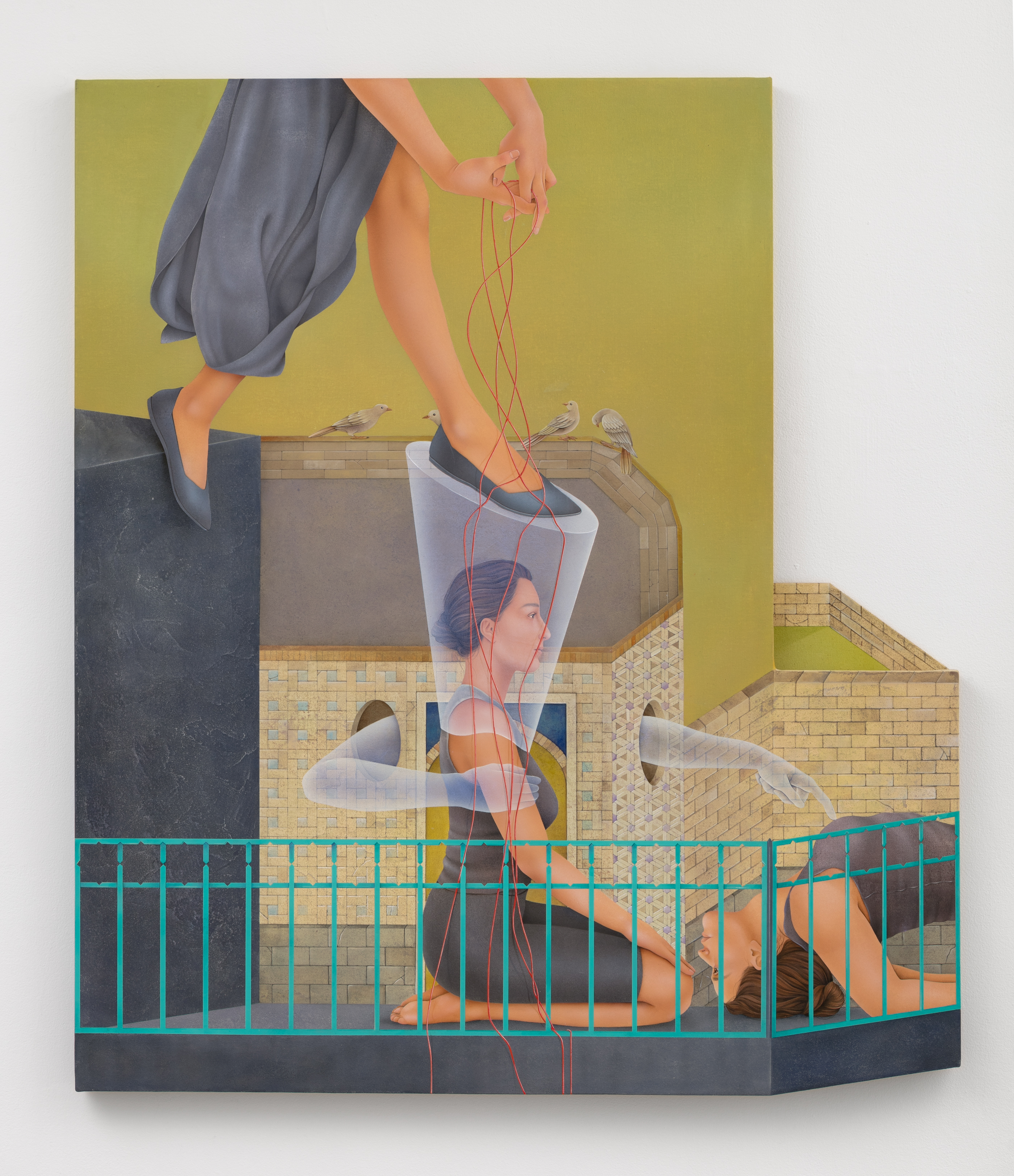
And what’s the significance of the red thread that runs through quite a lot of your works?
It started in one of my works a year ago. I was thinking about all the restrictions and things like lack of freedom of speech in Iran, and I wanted to find a visual symbol that could say that. I was thinking about the red lines that you shouldn’t cross, but I didn’t want it to be too direct and I didn’t want it to be violent.
The red line really has that balance between violence and something more delicate.
One of the things that I’m interested in having in my paintings is the notion of duality, and having imagery and elements from contrasting contexts. For example, having a figure which is supposed to be in a non-violent position or in an elegant or peaceful position, but overall what’s going on is suggestive that something not truly peaceful or even disturbing is happening. Another way of creating this contrast can be having something from a very old context, like a Persian miniature or Renaissance painting or medieval painting, and then juxtaposing it with something from a more contemporary context. It can also be Eastern versus Western elements or it can be a religious reference beside a secular one. I’m constantly thinking about these contrasting elements in my work.
Does a lot of your process come from traditional training? Or did you gradually introduce these techniques?
It’s something that I gradually did. For my undergrad, I studied graphic design. So I was not taught to be a painter back then. When I came to the US to study painting in graduate school, they don’t teach you how to paint. They mostly teach you how to think and they care more about the concept than how to paint. I tried to find my own way to use acrylic and different painting materials, so I was mostly self-taught.
You have been exploring three dimensions in your paintings. What made you want to bring this aspect into the work?
I’m trying to blend the boundary between when it is painted and when it’s actually three dimensional. I’m interested in confusing the audience in that way. In some of the paintings, I was trying to depict that with painting in some sort of trompe l’oeil, and I thought “Okay, what if I have both?” Again, it can also fit into that idea of having contrasting elements.
Where do you go for inspiration?
One of the main sources of inspiration for me is miniature painting, mostly Persian miniatures. The colour palette is always a huge inspiration; the vivid colours they use. The other thing I love in those works is how architecture is depicted. There’s no perspective in the way we know it now, and it’s interesting because it kind of restores and sometimes flattens the space. I’m interested in having that unreal space in my paintings, and figures that are rendered realistically within that unreal space.
“I think that in the end, we are all destined to be hopeful”
It almost feels like they’ve been transported into another dimension.
Exactly. And the other source of inspiration for me is Renaissance painting, mostly Italian Renaissance. I love how the composition, and everything, is just really thought through. I’m also inspired by Medieval painting because it happened at almost the same time as some of those miniatures, and it’s interesting to see that there are some overlaps. I also look at some more modern sources, for example, fashion photography, because I like to position my figures in poses that are non-violent and elegant, to address some issues that are totally different from what the pose suggests. The other reason is that I’m thinking about women’s rights and the patriarchy. There has been some progress in Western cultures, but still, you can see its presence in things like fashion. Women are still dictated to about what they wear, so I think it’s interesting.
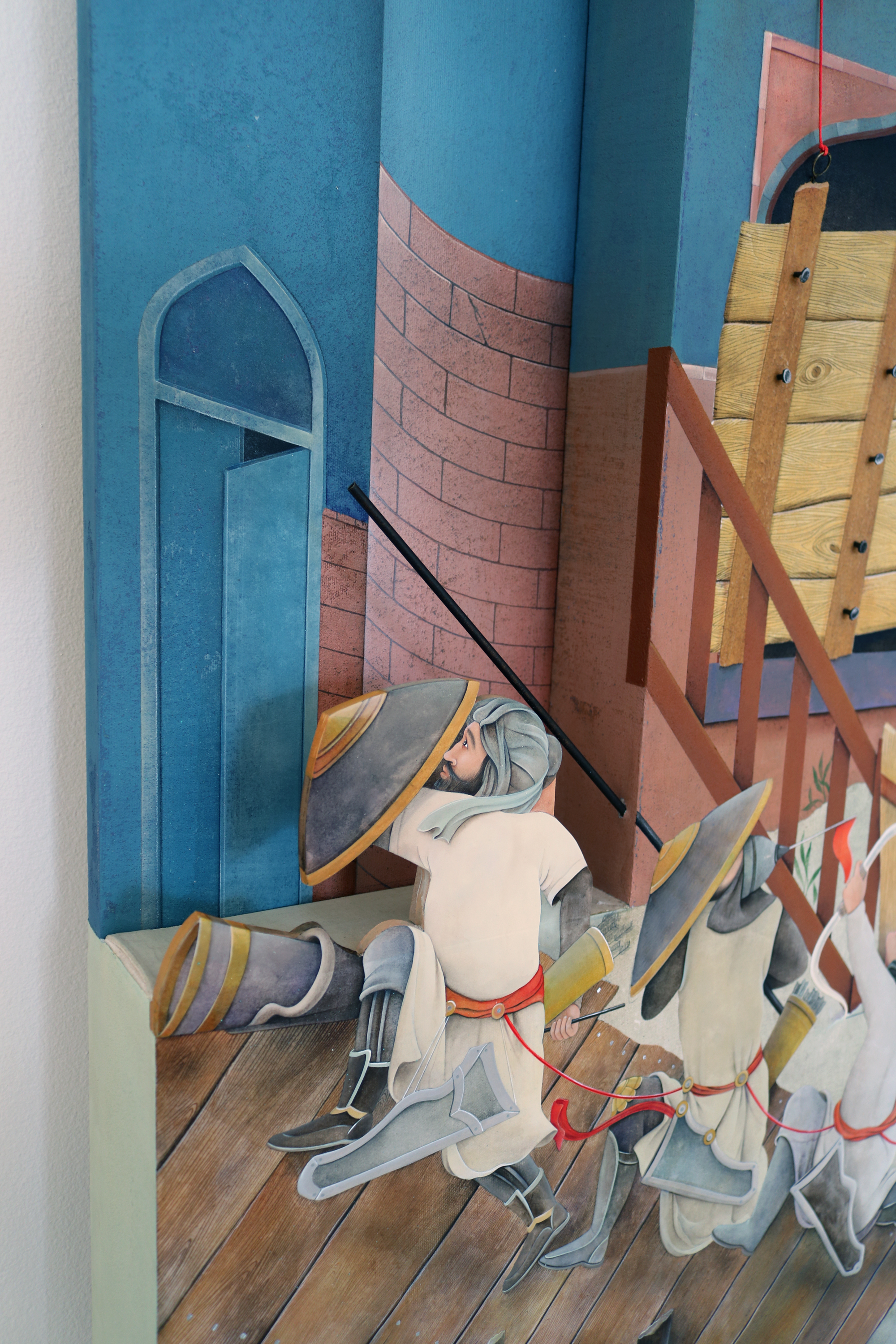
Your work makes me think of literature as well, it’s quite Kafkaesque, where people find themselves trapped in strange physical spaces as their narrative becomes more oppressive.
Yeah, exactly. And 1984. When I was reading that book, it was as if someone was explaining what was going on to us in Iran. It’s not as extreme as some other examples, for example, North Korea, and but it is similar to some extent.
Even in countries that appear to be free, people are still locked into modes of control, whether that be social customs, clothing rules and expectations, or technology and devices. Even when we have the illusion of freedom, we are still within this very controlled and monitored system.
Exactly. I mean, just look at what happened after the 2016 election, and the Cambridge Analytica scandal!
